Easy recipe for making soft and flaky Paratha, a popular pan-fried Indian flatbread made with whole wheat flour. Here's a detailed guide on how to make paratha dough the right way, with tips for rolling. Enjoy hot, crispy parathas with dal, curry, or eggs, or enjoy them with pickle and a hot cup of chai.
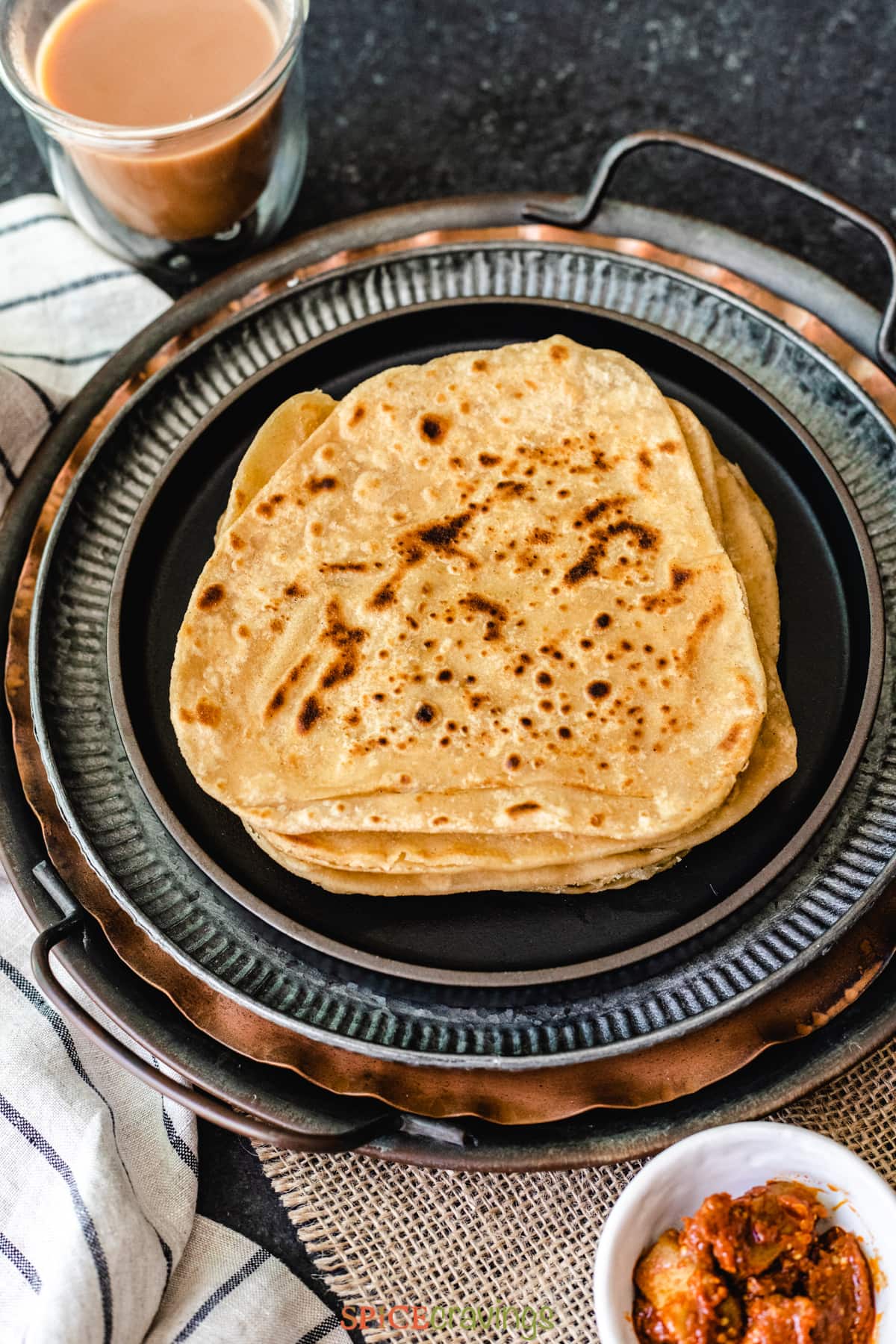
Jump to:
Growing up in a Punjabi home, Paratha was a staple in our meals. We enjoyed them for breakfast, lunch, or dinner. I've continued that tradition and now my girls prefer a crispy paratha over toast any day!
Most often on weekends, I make parathas with Egg Bhurji (Indian scrambled eggs) for breakfast, accompanied by a hot cup of Ginger tea.
And for days when I am super tired like when I'm filming recipes, I enjoy a hot & crispy paratha with pickle and Masala Chai, it's the ultimate comfort food for me! (check out more serving suggestions below!)
Making paratha from scratch may look intimidating, but it's easier than you think. Follow this step-by-step beginner's guide and learn how to make soft and flaky parathas at home!
What is Paratha?
Paratha is an unleavened layered Indian flatbread that is traditionally made with stone-ground whole wheat flour. A soft dough is made using flour, water, salt, and a little oil, then after a short rest, it is rolled out into flatbreads. Parathas are always pan-fried with ghee or oil until they turn golden crisp.
You can make parathas plain or stuff them with a variety of fillings. Some of the popular stuffed parathas include Aloo paratha (stuffed with potato), Gobi paratha (stuffed with cauliflower), and Paneer paratha, just to name a few.
Ingredients- Notes & Substitutions
It takes only three ingredients (not counting water) to make delicious and healthy parathas. Let's take a look at them and possible substitutions.
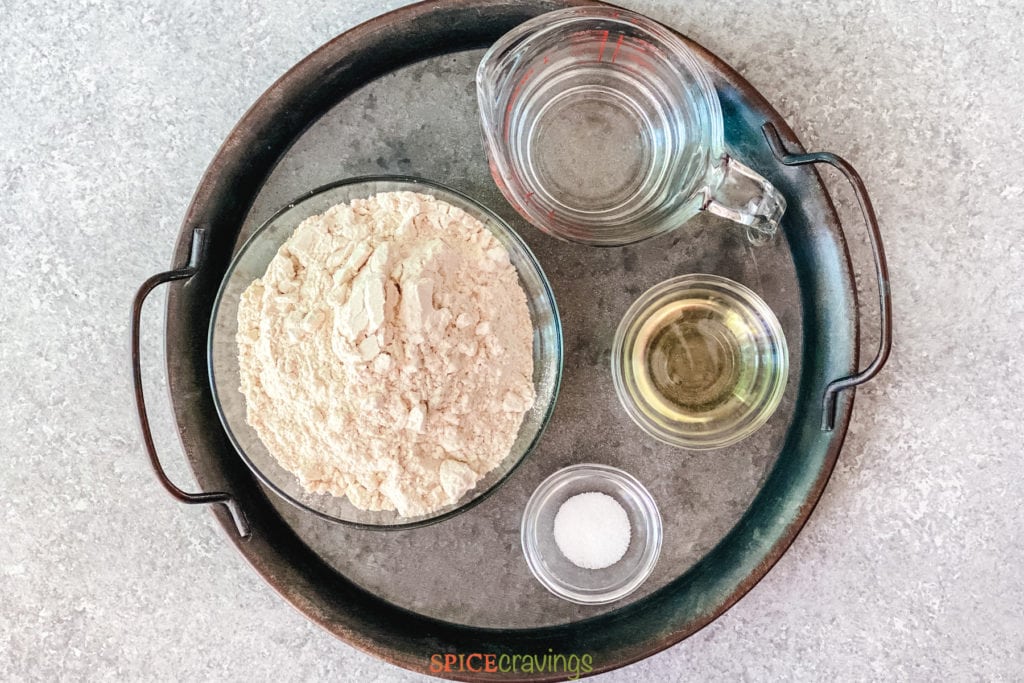
- Flour: I stick to the traditional choice and use a fine-ground whole-wheat flour called 'Atta'. But you can use fine-ground multigrain flour, ragi flour, or a combination of these as well.
- Water: Start with ¾ cup water for 2 cups of dough and add more as needed.
- Seasoning: I like to keep it simple and add a little salt. Sometimes I add ½ teaspoon of ajwain (carom seeds) or kalonji (nigella seeds) to add flavor.
- Oil or Ghee: I prefer the taste of homemade ghee in parathas, but this is totally your choice. To make vegan paratha, use olive oil or any clear oil of choice.
What is the best flour for paratha? Any whole-wheat flour that is finely ground is ideal for making parathas. I like Sujata Chakki Atta or Ashirvad Select Atta brands. For a variation, you can even use multigrain atta or ragi flour.
Equipment Needed to Make Paratha
- Rolling surface: Most Indian homes have a flat rolling surface for roti and paratha, called Chakla. You can use any flat surface, like a kitchen counter or a wooden cutting board.
- Rolling pin (belan): A good wooden rolling pin is essential for this recipe.
- Non-stick or caste iron frying pan: I prefer to use a non-stick pan, but a caste iron pan works well too.
- Spatula (for flipping): Any wide spatula for flipping will work here.
How to Make Paratha
1. Make paratha dough
This quantity of dough makes roughly 10 parathas. Adjust the quantity based on your need.
To make the dough, combine flour, salt, and 2 teaspoons of oil in the mixing bowl of a stand mixer, or any large mixing bowl (for kneading by hand). Attach the dough hook and run the mixer for 30 seconds, or mix the dough with your fingers.
Add water, starting with ¾ cup, and knead the dough for 1-2 minutes scraping the sides in between, until you form a semi-firm dough.
Note: Depending on the dough brand, it may take up to 1 cup of water for 2 cups of flour.
Cover the dough with a damp towel and rest it for 15-20 minutes for the glutens to develop. After that, knead the dough for 30 seconds.
How to fix dough (atta) consistency? After kneading, if your dough is too soft, add a couple of tablespoons of dry flour and knead it in. If the dough is too firm, add a tablespoon or two of water (gradually) and knead it again.
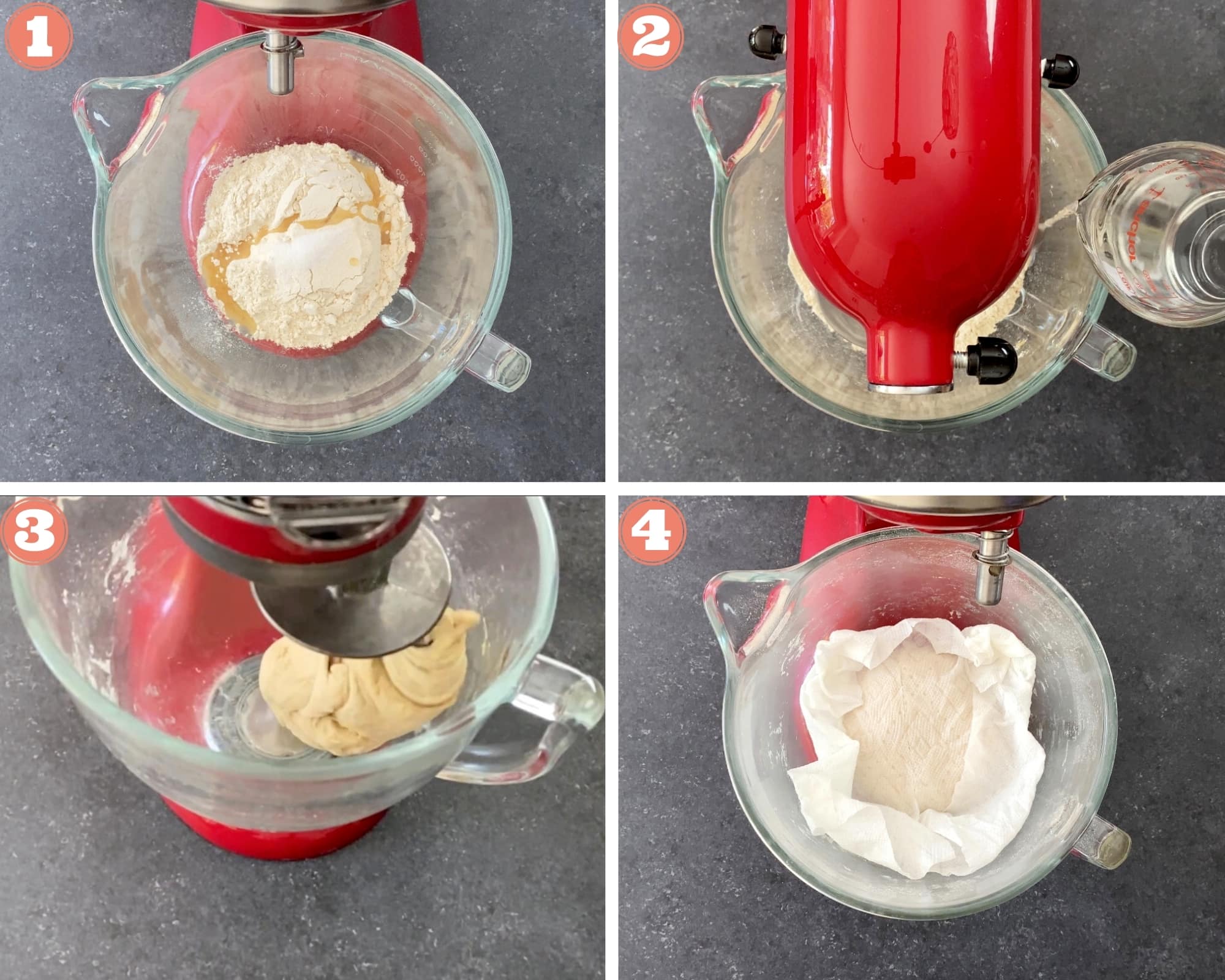
2. Divide & Flatten Dough Balls
Take some flour (about ¼ cup) on a plate or wide bowl for dusting the dough while rolling. Ensure that your rolling pin and surface are dry.
Divide: Divide the dough into 10 portions about the size of a lime, and roll each portion in your palms to make a smooth round ball.
Dust: Take one dough ball at a time, while covering the remaining dough with a damp towel. Lightly coat the dough with flour, shake off the excess, then place it on a flat rolling surface, like a chakla, countertop, or cutting board.
Flatten: Flatten it gently by pressing with your fingers. Using a rolling pin, start rolling in a circular motion, from the center in an outward motion. Roll till you form a 4-inch disc.
Spread ghee or oil: Using a spoon, spread about ½ teaspoon of ghee (oil for vegan)on the rolled-out disc.
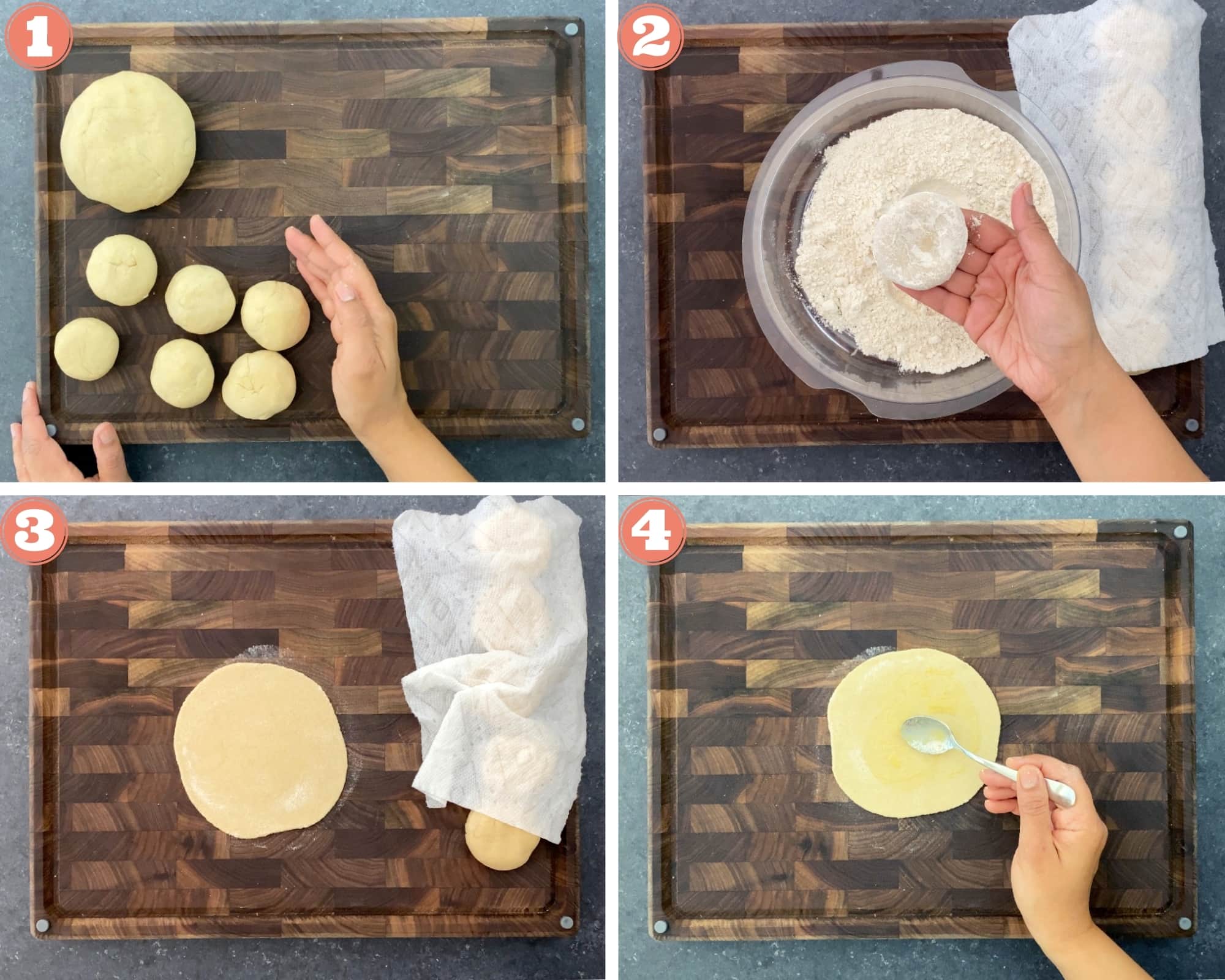
3. Roll Paratha (One of Two Ways)
Triangle Paratha
- Fold the greased disc into half to form a semi-circle.
- Now fold this in half to form a triangle.
- Dust the triangle or the square paratha lightly with flour on both sides and place it on the rolling surface.
- Using gentle circular motions, roll to flatten into ⅛-inch thickness. Dust with flour in between if the dough starts sticking. Using the shape you started with as a guide, roll all sides into an even thickness.
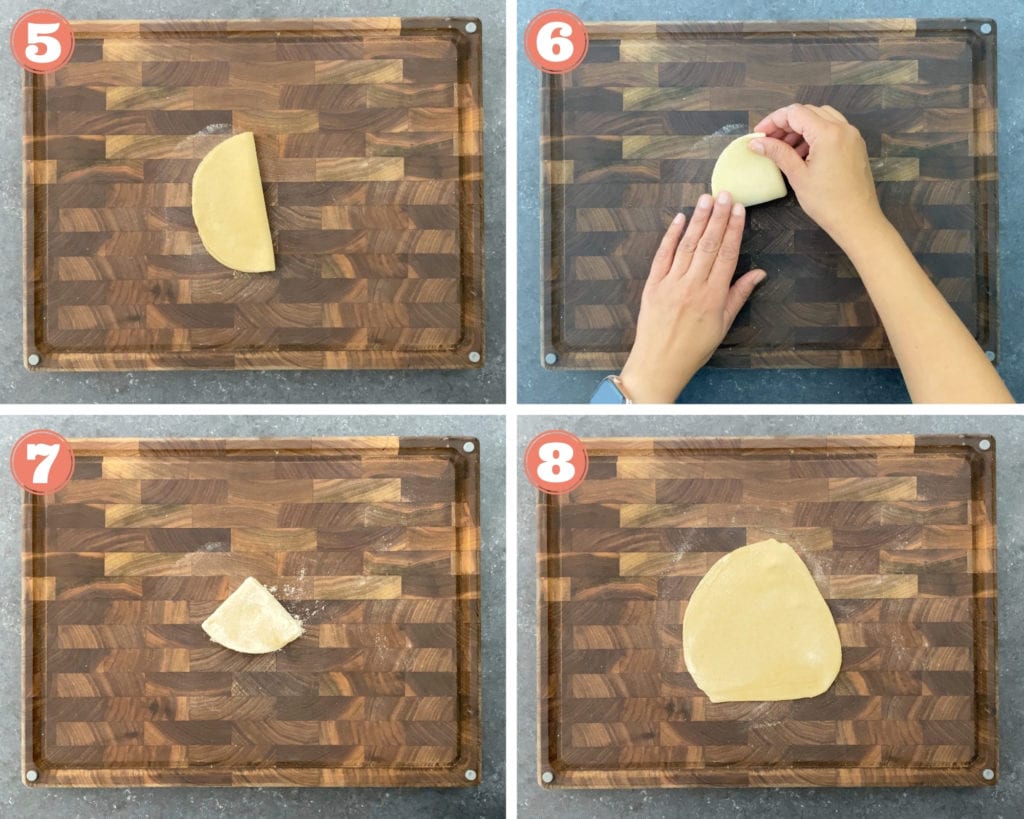
Square Paratha
- Visually divide the disc into 3 segments vertically. Fold over the left ⅓ segment over to the center. Now fold over the right ⅓ segment to the center, overlapping the first segment. You now have a rectangle.
- Fold the top ⅓ into the center. Now fold the bottom ⅓ into the center, overlapping the first side, thereby sealing the square.
- Dust the triangle or the square paratha lightly with flour on both sides and place it on the rolling surface.
- Using gentle circular motions, roll to flatten into ⅛-inch thickness. Dust with flour in between if the dough starts sticking. Using the shape you started with as a guide, roll all sides into an even thickness.
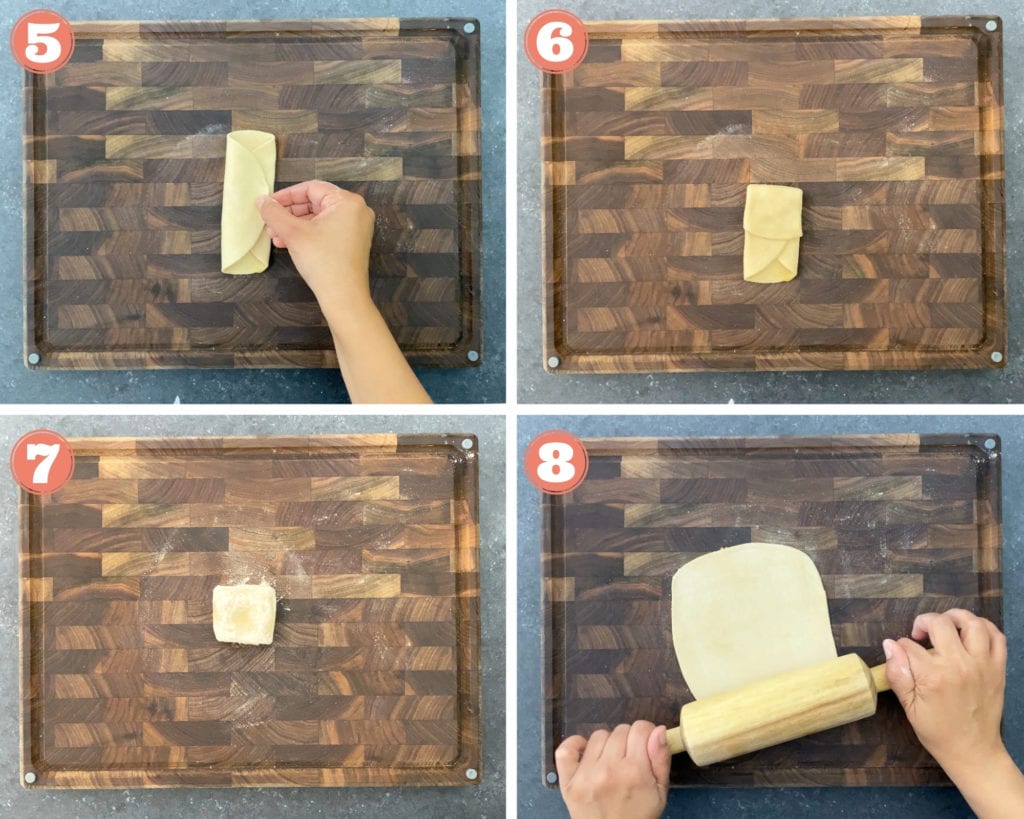
4. Cook Paratha
Heat a frypan on medium-high heat. Carefully place the rolled paratha. Let it cook for about one minute on the first side until you start seeing small bumps on the side facing up.
Flip the paratha using a spatula. Brush ghee or oil to coat the entire surface and continue to cook for about 1 minute.
Flip again and brush ghee or oil on the side facing up. Cook for about 1 minute, or until light brown spots start forming all over.
Gently press down with the spatula and rotate in a circular motion regularly. Flip and repeat on the other side, until the paratha looks crisp. Transfer to a plate or tortilla box. Repeat the process and make all parathas.
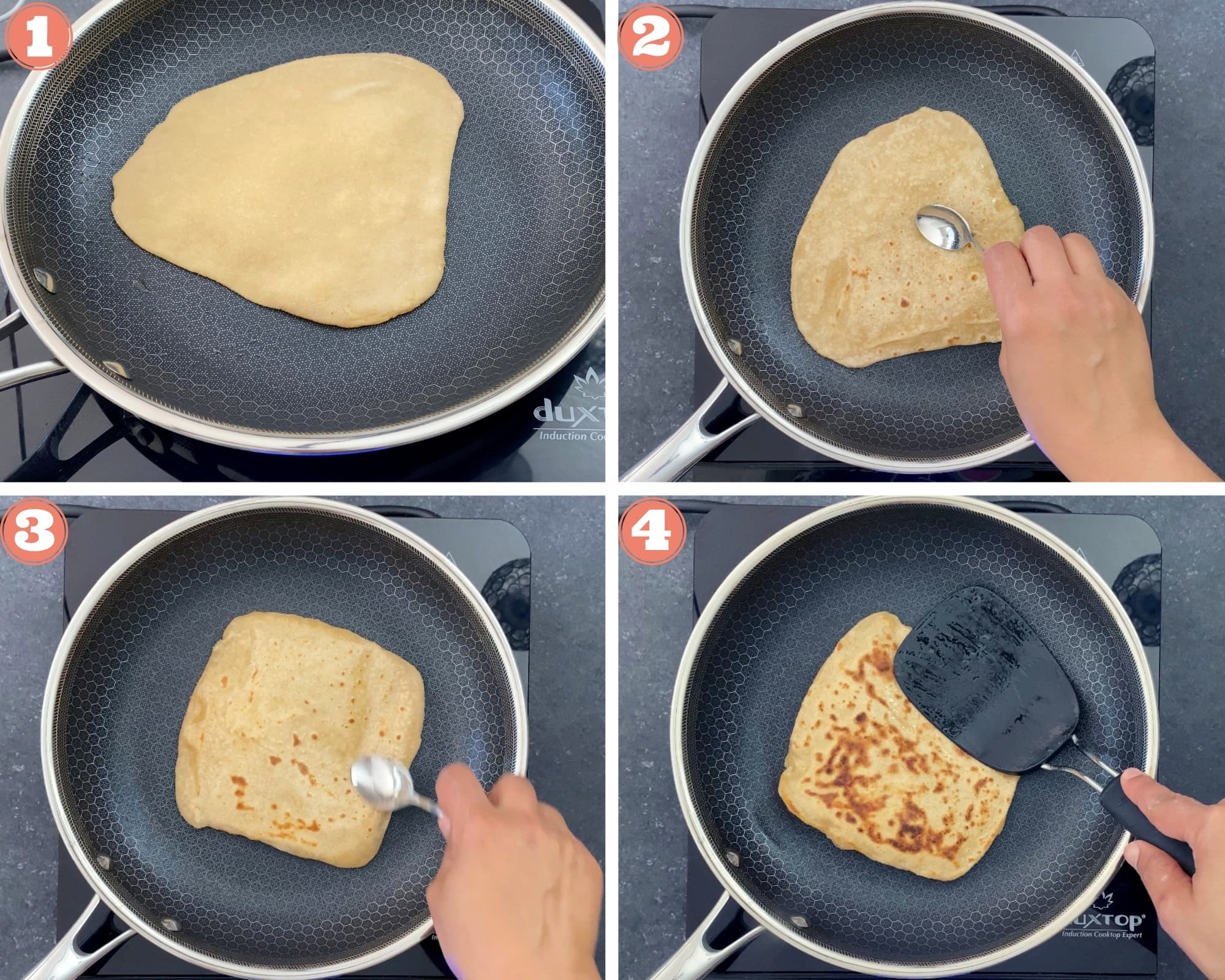
Serving Suggestions
I love serving parathas warm and crisp. Serve parathas with your favorite Indian dishes like:
- Breakfast: Serve with Egg Bhurji (Indian scrambled eggs) and Ginger Tea or Masala Chai.
- Dal or Beans: Chana dal, Dal makhani, or beans like lobiya, chana masala.
- Curry: Paratha pairs well with simple curries like Chicken curry, Mutton curry (lamb) or korma.
- Sabzi (stir-fry): Serve alongside Bhindi, Aloo Gobi, just to name a few.
- Wraps & Rolls: Parathas also make a great base for Indian-style wraps and rolls, like these Chicken kathi and Paneer Kathi Rolls.
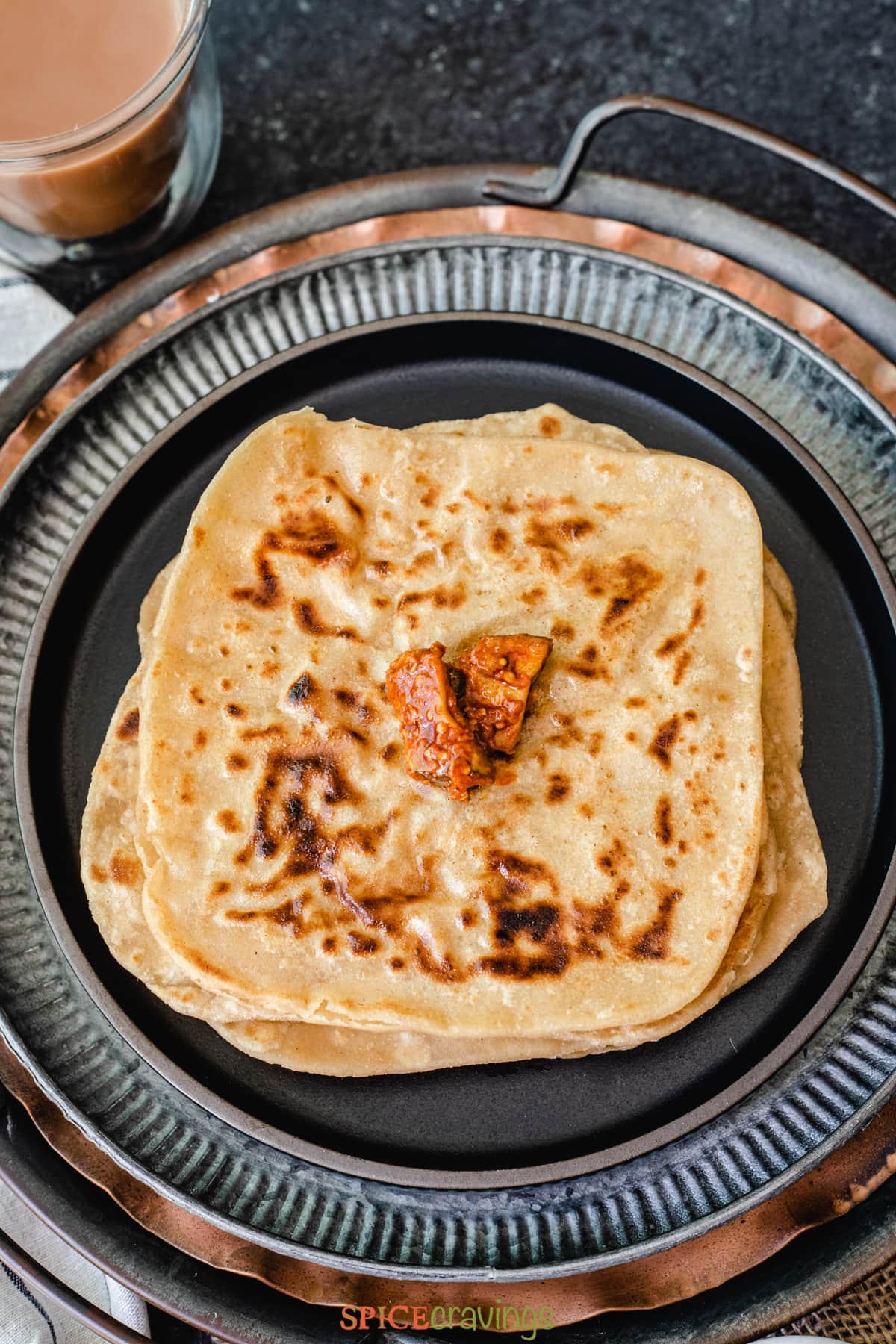
How to Store & Reheat
To keep parathas warm for longer, store them in a tortilla warmer, or an insulated container lined with a kitchen towel.
Refrigerate: To store leftovers, cool completely, then wrap parathas in aluminum foil or store them in an airtight container and refrigerate for up to 3 days. I do not recommend freezing parathas.
To reheat, heat them in a preheated fry pan for 30-40 seconds on each side. Alternatively, wrap them in a moist kitchen towel, and heat them for 20-30 seconds in the microwave.
Recipe Tips & Notes
Follow these tips and tricks for the best soft, yet crispy plain parathas:
- Water: When rolling the dough, start by adding 75% of the water, then add the remaining a little at a time. This ensures that your dough is not too soft.
- Dough: knead a dough that is of semi-firm consistency. It should be firmer than roti dough and softer than dough for poori.
- Resting: Let the dough rest for 15-20 minutes for the glutens to form. During this time keep it covered with a damp towel to prevent it from drying.
- Rolling & Toasting: Whether you're rolling the dough flat or toasting it later on, gentle pressure is critical to the outcome. Pressing the dough too hard results in stiff parathas.
Frequently Asked Questions
Paratha isn't unhealthy unless you cook it using a large quantity of ghee or oil. Since these flatbreads are made with whole wheat flour typically, parathas are rich in fiber and contain many nutrients found in whole grain flour. But like with everything that contains carbs, moderation is the key!
Paratha isn't unhealthy unless you cook it using a large quantity of ghee or oil. Since they are made with whole wheat flour typically, parathas are rich in fiber and contain many nutrients found in whole grain flours.
Paratha and Roti are both Indian flatbreads made with unleavened dough, but it's the cooking style that distinguishes them. Paratha is pan-fried using ghee or oil, whereas rotis are cooked on a tawa without any ghee or oil.
Both roti and paratha contain roughly the same quantity of carbs, if you want to pick a lower-calorie flatbread, roti is a better choice.
While both paratha and naan are flatbreads, parantha is made with unleaved flour, whereas Naan dough is made with yeast or leavening agents along with yogurt.
Yes! Since the dough of paratha is made using oil and flour, it is vegan. Be sure to use oil for pan-frying it to keep it vegan.
More Indian Flatbreads
★ Did you make this recipe? Please give it a star rating below! For more quick & easy recipes, FOLLOW ME on Facebook, Instagram, Pinterest and Youtube.
📖 Recipe
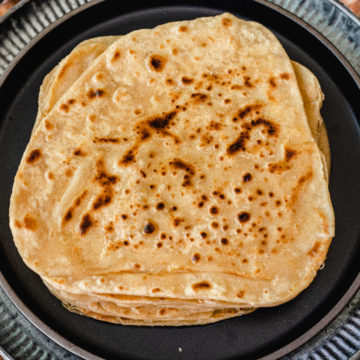
Paratha (Indian Pan-fried flatbread)
Equipment
Ingredients
Instructions
Prepare Dough
- To make dough, combine flour, salt and 2 teaspoons oil in the mixing bowl of a stand mixer, or any large mixing bowl (for kneading by hand). Attach the dough hook and run the mixer for 30 seconds, or mix the dough with your fingers.
- Add water, starting with ¾ cup, and knead the dough for 1-2 minutes scraping the sides in between, until you form a semi-firm dough. Note: Depending on the dough brand, it may take up to 1 cup water for 2 cups of flour.
- Cover the dough with a damp towel and rest it for 15-20 minutes for the glutens to develop. After that, knead the dough for 30 seconds.
Divide into Dough Balls
- Divide the dough into 10 portions about the size of a lime, and roll each portion in your palms to make a smooth round ball.
- Take one dough ball at a time, while keeping the remaining dough covered with a damp towel. Lightly coat the dough with flour, shake off the excess, then place it on a flat rolling surface, like a chakla, countertop, or a cutting board.
- Flatten it gently by pressing with your fingers. Using a rolling pin, start rolling in circular motion, from the center in an outward motion. Roll till you form a 4-inch disc. Using a spoon, spread about ½ teaspoon of ghee (oil for vegan)on the rolled out disc.
Shape Paratha (One of Two Ways- Triangle or Square)
How to Make Triangle Paratha
- Fold the greased disc into half to form a semi-circle.
- Now fold this in half to form a triangle.
How to Make Square Paratha
- Visually divide the disc into 3 segments vertically. Fold over the left ⅓ segment over to the center. Now fold over the right ⅓ segment to the center, overlapping the first segment. You now have a rectangle.
- Fold the top ⅓ into the center. Now fold the bottom ⅓ segment into the center, overlapping the first side, thereby sealing the square.
Roll Paratha
- Dust the triangle or the square paratha lightly with flour on both sides and place it on the rolling surface. Using gentle circular motions, roll to flatten into ⅛-inch thickness. Dust with flour in between if the dough starts sticking. Using the shape you started with as a guide, roll all sides into an even thickness.
Cook Paratha
- Heat a fry pan on medium-high heat. Carefully place the rolled paratha. Let it cook for about 1 minutes on the first side, until you start seeing small bumps on the side facing up.
- Flip the paratha using a spatula. Brush ghee or oil to coat the entire surface and continue to cook for about 1 minute.
- Flip again and brush ghee or oil on the side facing up. Cook for about 1 minute, or until light brown spots start forming all over. Gently press down with the spatula and rotate in a circular motion regularly. Flip and repeat on the other side, until the paratha looks crisp.
- Transfer to a plate or tortilla box. Repeat the process and make all parathas.
Video
Notes
- Water: When rolling the dough, start by adding 75% of the water, then add the remaining a little at a time. This ensures that you dough is not too soft.
- Dough: knead a dough that is of semi-firm consistency. It should be firmer than roti dough and softer than dough for poori.
- Resting: Let the dough rest for 15-20 minutes for the glutens to form. During this time keep it covered with a damp towel to prevent it from drying.
- Rolling & Toasting: Whether you're rolling the dough flat or toasting it later on, gentle pressure is critical to the outcome. Pressing the dough too hard results in stiff parathas.


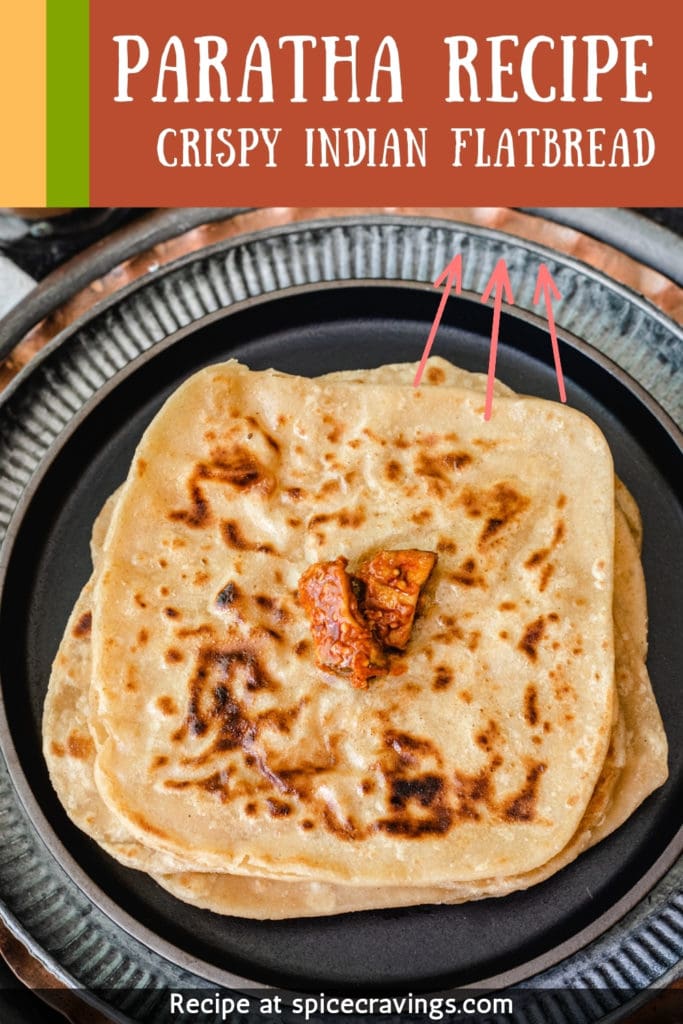
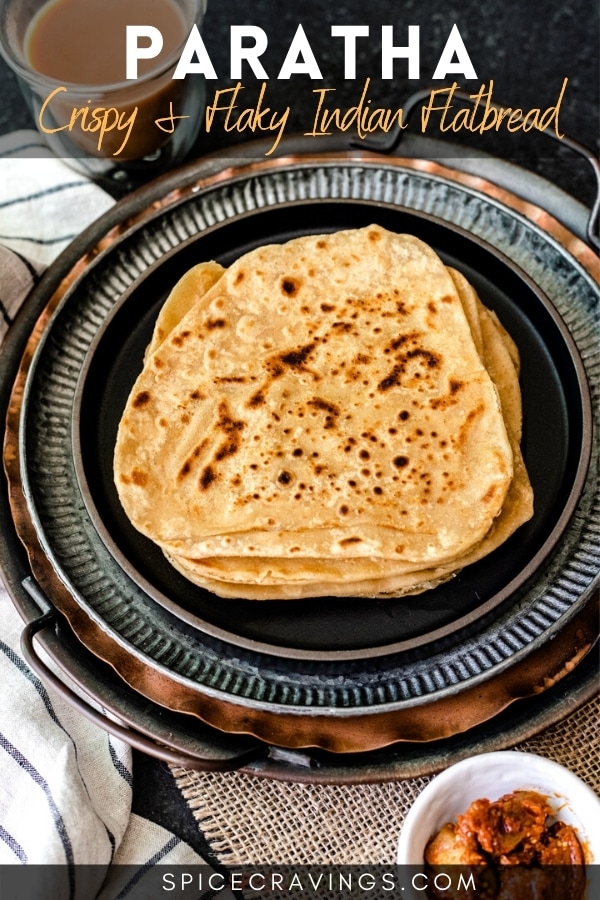
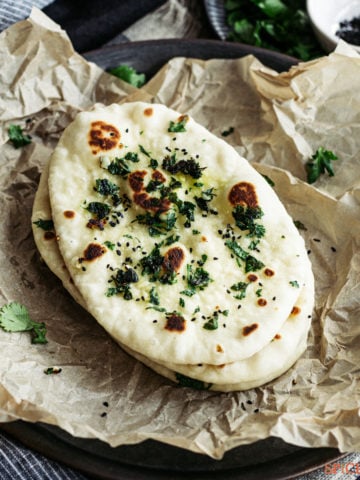
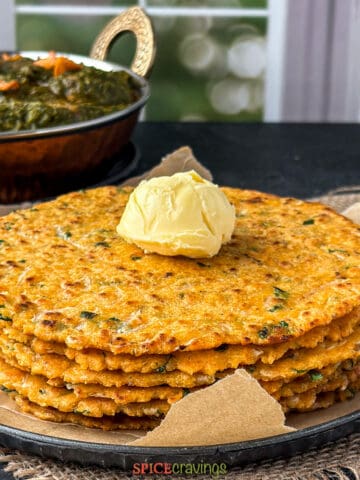
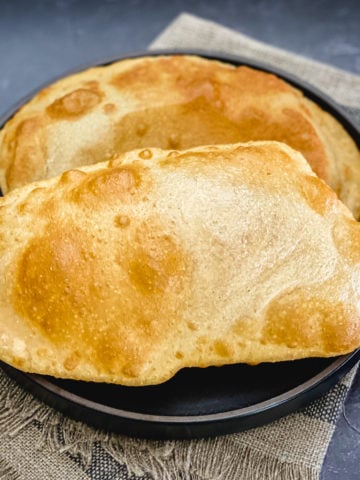

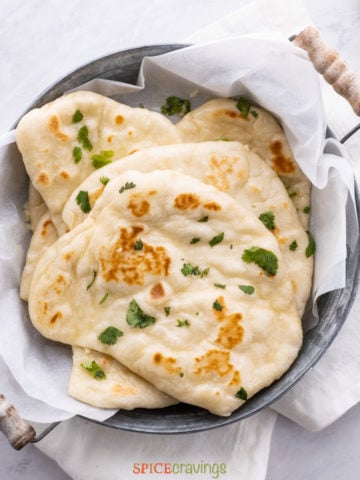

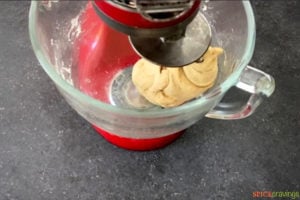
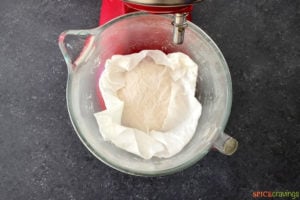
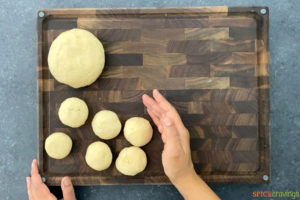

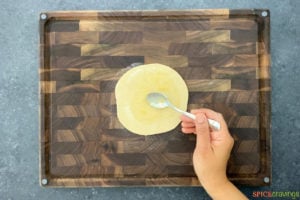
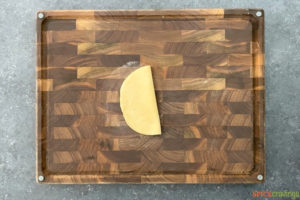
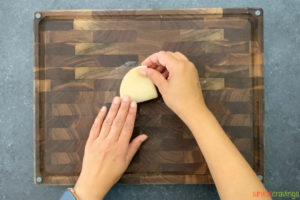
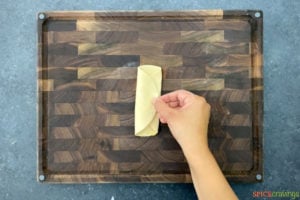
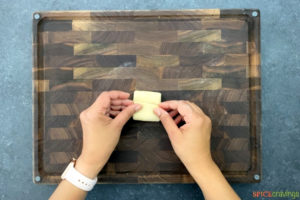
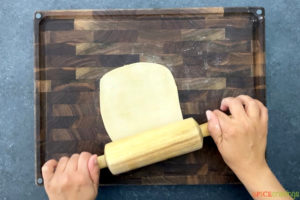
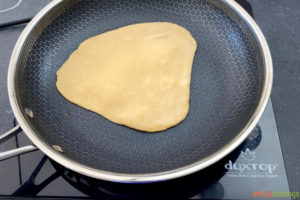
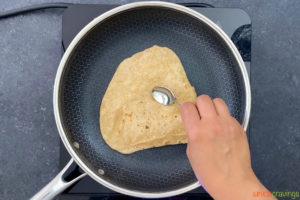
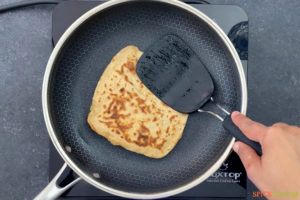
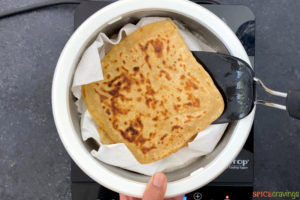
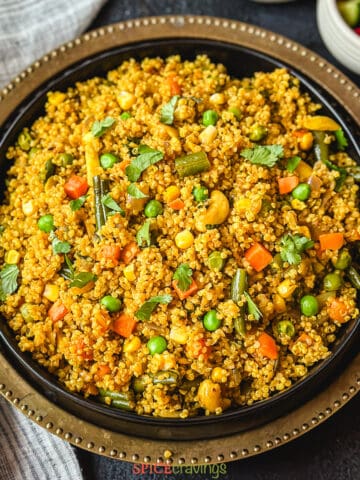
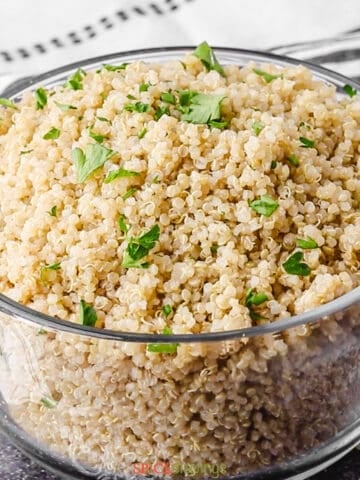
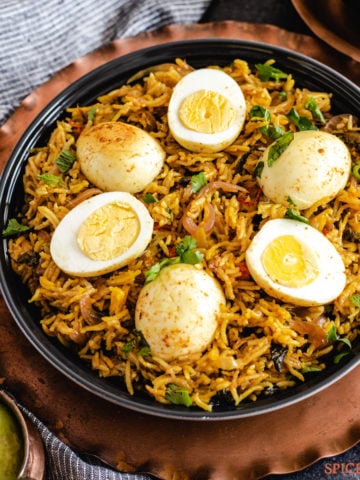


Leave a Reply